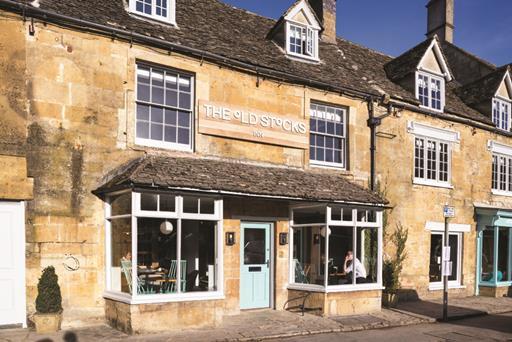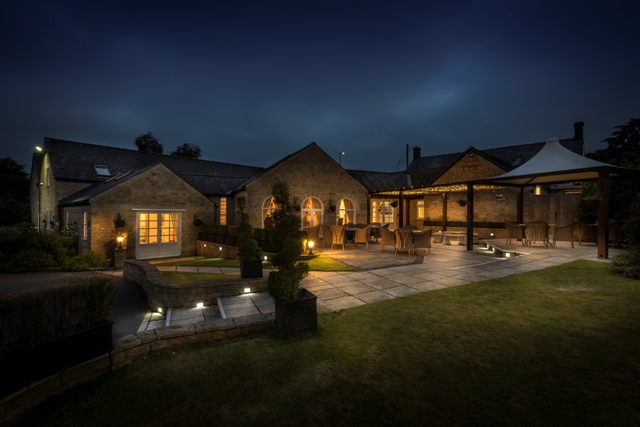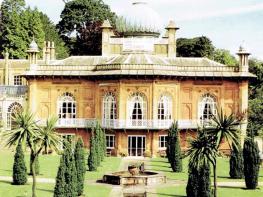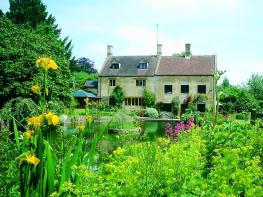This historic hotel has been providing accommodation for hundreds of years and today offers high…
Sezincote House and Bourton-on-the-Hill

Discovering the influences of India through the Cotswold home of Sir Charles Cockerell
6 miles (9.7kms)
About the walk
For anyone with a fixed idea of the English country house, Sezincote will come as a surprise. It is, as the poet John Betjeman said, ‘a good joke, but a good house, too’. Built on the plan of a typical large country house of the era, in every other respect it is thoroughly unconventional. A large copper onion dome crowns the house, while at each corner of the roof are finials in the form of miniature minarets. The walls are of Cotswold stone, but the Regency windows and decoration owe a lot to Eastern influence.
Hindu architecture
Sezincote is a reflection of the fashions of the early 19th century. Just as engravings brought back from Athens had been the inspiration for 18thcentury Classicism, so the colourful aquatints brought to England from India by returning artists such as William and Thomas Daniell were a profound influence on architects and designers. Sezincote was one of the first results of this fashion. When Sir Charles Cockerell, who had made his wealth in the East, retired from the East India Company, he had the house built by his brother, Samuel Pepys Cockerell, an architect. The eminent landscape gardener Humphry Repton helped Cockerell to choose the most picturesque elements of Hindu architecture from the Daniells’ drawings.
The garden buildings took on elements from Hindu temples, such as a lotus-shaped pool, Hindu columns supporting a bridge and snakes, sacred bulls and lotus buds. The Prince of Wales was an early visitor. The experience obviously made an impression as the intensely Mogul-influenced Brighton Pavilion arose not long after. Betjeman was a regular guest at Sezincote and described it thus, ‘Stately and strange it stood… Indian without and coolest Greek within, looking from Gloucestershire to Oxfordshire.’
The walk takes you through the small village of Bourton-on-the-Hill, home to 18th-century Bourton House, which is worth a visit for its award-winning garden and Grade I listed 16th-century Tithe Barn.
Walk directions
From the Black Bear Inn, cross the High Street and into Corders Lane. Cross a road at the end onto a footpath, heading past allotments to a kissing gate. Cross a grassy field, bending right at the far end; immediately before a prominent oak tree, bend left through a kissing gate in the hedgerow, then right again. Continue over a sleeper bridge to another kissing gate. Continue straight ahead through five more fields via kissing gates, then pass through a gap in the hedgerow. The path now bears slightly right towards the far tip of some woodland.
Cross a kissing gate and sleeper bridge, then head right to a second small bridge. Veer slightly left of the woodland before taking a left turn through a kissing gate in the hedgerow. Cross another field, then bear slightly right after a kissing gate. About 100yds (91m) up this next field turn left by a gate, crossing the middle of the field to the far left corner.
Exit left onto a driveway. Turn right at the end, following the pavement into Bourton-on-the-Hill and almost to the church. Turn left into a lane by a cottage called Quarry Stones, bear right and then take a signed footpath left up a track between walls.
Go through a field gate and continue over fields passing through two more field gates. Continue over a stile and a gateway to reach a newly planted woodland, walking just right of this to reach Sezincote Estate via two kissing gates amid a tree belt. Go straight ahead, then cross a drive. Dip gently down, going slightly left through a small gate to join the path that runs alongside woodland. Go through two further gates (between ponds) and an open gateway following the fenceline in the next field. Sezincote House will soon become visible to the right.
At the far end go through an open gateway, then a kissing gate. Turn left on a tarmac lane, passing the Keepers Cottages to your left, and on through a gate. If you want to avoid the herd of cattle in this or the next fields follow the fenced corridor signposted along the left boundary that runs parallel with the lane. Where the road bears left at Upper Rye Farm, go slightly right on a continuation of the vehicle track and through a gate. Pass a barn to your left and go through a field gate.
Go straight down the field and through a field gate in the far corner. Bend right around a corner of woodland, and follow the path across the field. Half way over, at a crossing of footpaths to the left of a low tree stump, turn left. Exit the field through a gate.
Continue along the right margin of a field, through a gate and straight ahead across the next field to its far left corner. Now follow the left margin of the following two fields. Towards the end of the second, turn left at a waymarker.
Continue through a gap ‘gate’ in the hedgerow, and keep towards the left edge of the grassy area to a field gate. Follow a shady path that first becomes a grassy track behind houses, then a tarmac lane beyond some garages. Follow this as it bends right to the main road. Turn left at the top to return to the start.
Additional information
Fields, tracks and lanes, pavement, several stiles
Fields on lower edge of escarpment
Under close control – likely to be a lot of livestock
OS Explorer OL45 The Cotswolds
Old Market Way car park, near the station
Next to the Town Hall, Moreton-in-the-Marsh
WALKING IN SAFETY
Read our tips to look after yourself and the environment when following this walk.
Find out more
Also in the area
About the area
Discover Gloucestershire
Gloucestershire is home to a variety of landscapes. The Cotswolds, a region of gentle hills, valleys and gem-like villages, roll through the county. To their west is the Severn Plain, watered by Britain’s longest river, and characterised by orchards and farms marked out by hedgerows that blaze with mayflower in the spring, and beyond the Severn are the Forest of Dean and the Wye Valley.
Throughout the county you are never far away from the past. Neolithic burial chambers are widespread, and so too are the remains of Roman villas, many of which retain the fine mosaic work produced by Cirencester workshops. There are several examples of Saxon building, while in the Stroud valleys abandoned mills and canals are the mark left by the Industrial Revolution. Gloucestershire has always been known for its abbeys, but most of them have disappeared or lie in ruins. However, few counties can equal the churches that remain here. These are many and diverse, from the ‘wool’ churches in Chipping Campden and Northleach, to the cathedral at Gloucester, the abbey church at Tewkesbury or remote St Mary’s, standing alone near Dymock.
Nearby stays
Restaurants and Pubs
Nearby experiences
Recommended things to do
Why choose Rated Trips?
Your trusted guide to rated places across the UK
The best coverage
Discover more than 15,000 professionally rated places to stay, eat and visit from across the UK and Ireland.
Quality assured
Choose a place to stay safe in the knowledge that it has been expertly assessed by trained assessors.
Plan your next trip
Search by location or the type of place you're visiting to find your next ideal holiday experience.
Travel inspiration
Read our articles, city guides and recommended things to do for inspiration. We're here to help you explore the UK.













